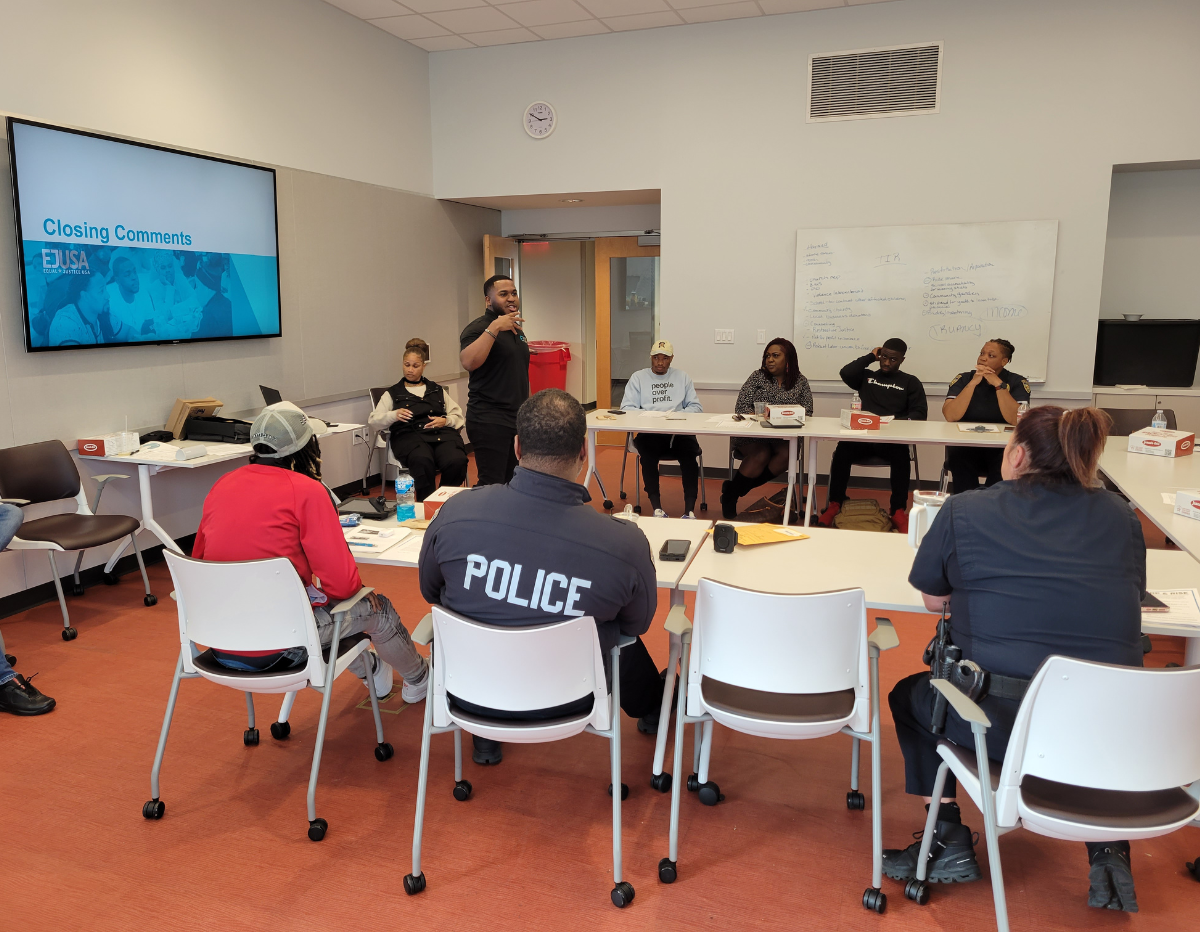
In 2016, we launched a groundbreaking program in Newark, NJ, that brought community members and police officers into the same room to explore trauma — especially as it is connected to encounters with policing. And we wanted to explore the trauma of both groups. Since then hundreds of community members and police officers have gone through the two-day workshop. The police department saw a dramatic decline in citizen complaints from those who had been in the program, and Trauma to Trust has become a critical component of the community-centered public safety model that is thriving in the city.
Representatives from Baton Rouge visited Newark several times over the years to see Trauma to Trust and other key components of the public safety model. In March, we had the official launch of the program and we’re excited to keep building in that city.
EJUSA: When did Baton Rouge get off the ground?
Lionel Latouche: We had been working there before as part of a program called Collective Healing, and EJUSA provided assistance to grassroots organizations in a handful of cities. Our partnership with our Baton Rouge partners had gone really well. Right before the pandemic, we started talking about how we might bring Trauma to Trust to Baton Rouge. Then the pandemic happened, and I actually didn’t get to go down there until December 2021. We talked about the history of T2T and the impact it was having in Newark.
Automatically, a lot of stories came up and there was a clear need to talk about trauma. What was clear was that Baton Rouge needed language about recognizing and expressing the impact of trauma. They knew that they were experiencing trauma, and there was some language, but it was scattered depending on who you were talking to. That was a big step. I also made some important relationships with folks and shared the vision of T2T as well as my experience with trauma. In March 2022 we did our first listening sessions and those continued until January 2023.
We really needed to capture the voice of community. And the beauty was we really began to understand the experience of Baton Rouge, and they informed the direction we went.
EJ: How were police involved in the planning?
LL: Absolutely, from early on. The training division was involved in the primer session we had (an introduction to T2T). You heard the perspective of law enforcement in the south. This was a year removed from the public execution of George Floyd and the national uprisings. There was a little bit of defensiveness, some “Hey, understand me.” But there was also true willingness to get messy and learn. It was important that they were there sitting with community.
We also had a listening session with only cops, about 15. They shared their own opinion and it was interesting. You get in those spaces and the group says, “Everything is fine.” And then one person opens up and then everyone jumps in and it’s not as fine as it appeared. It was important for that to happen because we needed their perspective.
EJ: Any other listening sessions stand out?
LL: Well, we had one for white folks. I had to point that out, that white folks had their own category, acknowledging that the Black community asked if white people are going to be in the room. In Newark, it didn’t matter, we were going to do what we needed to do. But because of the racist legacy of the South, the Baton Rouge community stressed the importance of white community members being a part of the conversation. This is a city where Black people live on the other side of the tracks as white people, and they’re not interfacing unless something big is happening in the community.
EJ: What struck you as the biggest differences between T2T in Baton Rouge and in Newark?
LL: The clearest thing is the legacy of racism and oppression in the South. The impact of slavery and segregation is still really clear. We had to be prepared for that. It showed up in how we created the experience and curate conversation. In Newark, you have the 1967 rebellion, a clear stance by the community that this is not right. It’s part of the ethos in Newark. It’s different down in Baton Rouge. The nicety of southern culture is different. But when you get to a place of ruffling feathers, there’s a volcanic explosion of emotion and frustration and straight-up racism. We needed to be cognizant of how that showed up. Events had happened in the city in the lead-up to T2T that were clear to us that the waters of racism settle but only for a short time until something happens and there’s a huge flood.
And to be real, we had to show up in our northern culture and know how to present things that met the cultural dynamics of Baton Rouge to make the experience palpable for folks. We’re a little more in your face coming from Newark. And there’s an advantage to that. We had to navigate through the Baton Rouge culture to get to the same emotional points while respecting the dynamic.
EJ: You’ll go back in the fall for a full slate of sessions. How will your learnings from the spring affect the next chapter in Baton Rouge?
LL: We really saw the desire of the people down there to tell stories. In BR, being able rub shoulders, to sit in groups and hear each other’s voices, that feels really important. We want to make sure that the folks have the space and the comfort to share those stories and experience one another.


